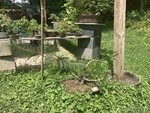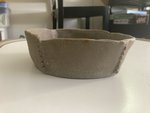I just read through this thread, and it appears to me that you’re trying to have too many sacrifices working all at once. You have an apical sacrifice, a lower right sacrifice, a lower left sacrifice... the whole tree is a sacrifice!
And, then, the sacrifice branches aren’t allowed to grow properly to do their job, which is to fatten the trunk. Why do I say this? Because they’re not growing UP, they’re growing out sideways.
Those trees that Frank posted, the ones with the fat trunks, they were grown with a single apical sacrifice, that was allowed to grow up, then chopped. A replacement sacrifice was then chosen to grow up, then it was chopped. Meanwhile, little lower branches were retained to eventually design the tree.
Low sacrifice branches just don’t really work to fatten the lower trunk very well. They didn’t produce the auxin that stimulates wood production. The most wood production will be produced to support the bud producing the most auxin, which is the apex, the highest point in the tree. If you have a low sacrifice branch 59 fatten the low parts of the tree, you have to let it grow tall, not “out”. It has to become the tallest point if the tree to become effective and build wood.
Any other way just confuses the tree, and you don’t get satisfactory results.
Here are the JBP growing at Telperion Farms:
View attachment 316588
they have a single sacrifice, an apical sacrifice they let get 15 feet tall, then chop it back to 12 inches, select another sacrifice, and do it again!
It creates trunk lines like this:
View attachment 316589
You can see the secondary sacrifice is still there on that photo.
After a couple years of refinement, you get something like this:
View attachment 316590
This tree was created by using only apical sacrifice branches, one at a time. Retaining lower branches to eventually become the primary branches of the tree.










